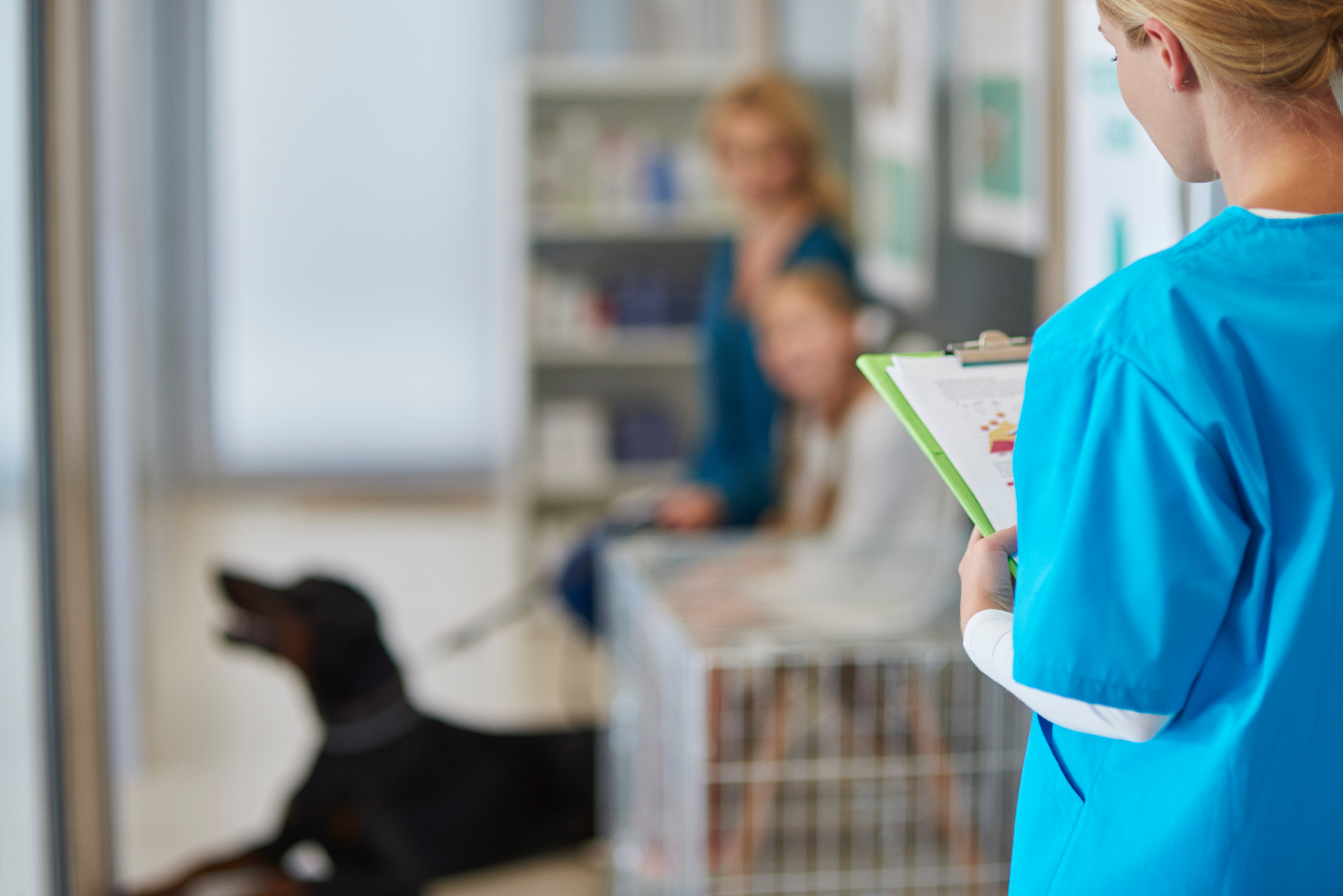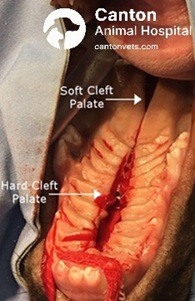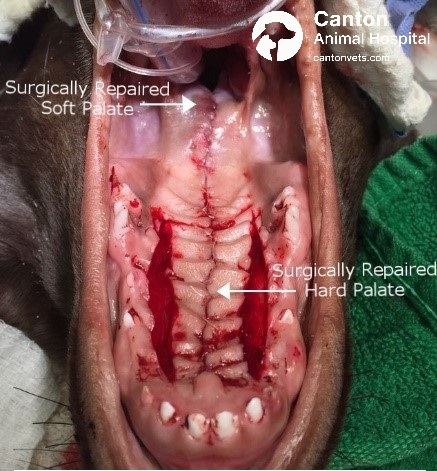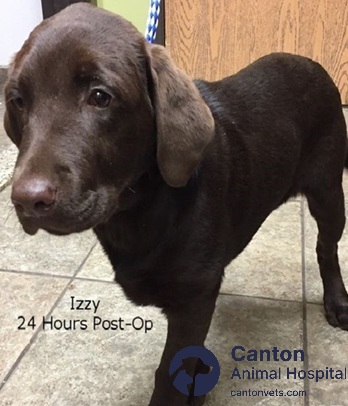Home | Surgeries | Cleft Palate Repair in Puppies and Kittens
Cleft Palate Repair in Puppies and Kittens
Cleft Palate Repair in Puppies and Kittens
At Canton Animal Hospital, we offer compassionate, comprehensive care for puppies and kittens born with cleft palates. A cleft palate is a congenital defect where there is an opening between the mouth (oral cavity) and the nose (nasal cavity) due to incomplete fusion of the tissues during development. It can affect the hard or soft palate and may occur alongside cleft lip (primary cleft palate).
These defects can prevent normal nursing, result in malnutrition, and allow food or fluids to pass into the nasal cavity, leading to infections or life-threatening pneumonia. Early diagnosis and appropriate management—including surgical repair and supportive care—are key to helping affected puppies thrive.
Types of Cleft Palates
Primary cleft palate: Also known as cleft lip or harelip, involves the lip and front of the mouth.
Secondary cleft palate: Involves the hard and/or soft palate inside the mouth and may vary in width and length.
Severe cases where a large portion of the palate is missing may not be surgically manageable. Humane euthanasia should be considered if the defect prevents adequate feeding and quality of life.
Featured Resources

We Welcome New Patients!
We're always happy to give your furry friend care at our hospital. Get in touch today!
Contact UsClinical Signs of Cleft Palate in Puppies
Difficulty or inability to nurse (no suction ability)
Milk or formula leaking from the nose during feeding
Coughing, gagging, or sneezing during eating or drinking
Poor weight gain or failure to thrive
Nasal discharge or chronic nasal infection
Frequent respiratory infections or aspiration pneumonia
Risk Factors
Hereditary factors (especially in brachycephalic and toy breeds)
Breeds commonly affected: Boston Terriers, Bulldogs, Pekingese, Miniature Schnauzers, Beagles, Dachshunds, Cocker Spaniels, and Siamese cats
Environmental influences during pregnancy: viral infections, toxin exposure, or poor maternal nutrition

Diagnosing Cleft Palate in Newborns
Visual exam of the roof of the mouth to detect a midline gap or dark line
Palpation using a clean finger to detect any indentation in the palate
Observation of nursing behavior and weight gain
Lack of suction or frequent air-filled (bloated) bellies may indicate a cleft
Chest X-rays to check for pneumonia if respiratory issues are present
Early diagnosis allows for supportive feeding interventions and surgical planning.
Initial Care and Feeding Management
Because cleft palate puppies cannot nurse effectively, alternative feeding methods are essential for survival and healthy development.
Tube or syringe feeding: These methods are used in the first 4–8 weeks of life, ensuring your puppy receives adequate nutrition. Syringe feeding involves gently placing a soft-tipped syringe in the mouth, while tube feeding may be done by a trained caregiver or veterinarian.
Esophagostomy tubes: A more comfortable long-term feeding solution, this tube is placed through the neck into the esophagus, allowing food to bypass the cleft entirely. It simplifies feeding, especially for owners managing multiple feedings daily.
Feeding consistency: Use blenderized diets, meat-based baby food, or prescription recovery formulas designed for puppies. Food should be slightly warm (not hot) and of a smooth, pudding-like texture to reduce the risk of aspiration.
Feeding position: Keep the puppy upright during and after feeding. Cradling or using a puppy feeding sling can help prevent formula from entering the nasal passages and reduce the risk of pneumonia.
Feeding frequency: Small meals 4–6 times per day are typically recommended. Monitor daily weight gain to ensure progress.
Water: As puppies wean, provide plain water in a low dish. Water helps rinse the nasal passages naturally, especially in unrepaired clefts.
Hygiene: Keep feeding equipment sterile, and monitor for signs of nasal discharge or respiratory infection, which can indicate aspiration.
Proper feeding support is critical to help these puppies grow strong enough for surgery, and it also improves their comfort and quality of life.

Surgical Repair of Cleft Palate
Surgical correction is typically performed at 3–4 months of age, once the puppy is strong and has reached adequate body size.
Tissues from the sides of the mouth (mucosal flaps) are used to close the defect
In some cases, tissue from lips, cheeks, or forehead may be used
Full closure restores separation between nasal and oral cavities and prevents future infections
Puppies with small soft palate clefts may only require canned food post-op, while those with hard palate involvement will need extended soft/blenderized diets.
Potential Surgical Complications
Swelling of the soft palate can cause snoring and temporary difficulty eating
Self-trauma from pawing or tongue rubbing may reopen the surgical site
Nasal discharge or sneezing may occur if small openings remain (oronasal fistulas)
Growth-related changes can cause repaired areas to weaken, requiring revision surgery.

Postoperative Care
Soft diet or tube feeding for 2–4 weeks
No hard toys or treats for 4–6 weeks
E-collar for 1–2 weeks to prevent facial rubbing or licking
Antibiotics if infection or pneumonia is present
Recheck appointments to monitor healing and surgical site integrity
Prognosis and Prevention
Prognosis is excellent for small or moderate clefts treated surgically
Extensive defects involving more than half the hard palate are more challenging
Affected pets and their parents should not be bred to prevent hereditary transmission
Feeding Do’s & Don’ts (First 2–4 Weeks)
Do
Feed soft, blenderized food (meat baby food, canned recovery diets, or soaked kibble)
Use a feeding syringe or shallow bowl for gentle delivery
Feed small amounts frequently—4 to 6 meals per day
Provide fresh water in a low, shallow bowl
Keep your puppy upright during and after feeding to reduce aspiration risk
Monitor for sneezing, nasal discharge, or coughing during/after meals
🚫 Don’t
No hard kibble, treats, or chew toys
Avoid force-feeding or squeezing too much food at once
Don’t let your puppy play, chew, or lick their mouth excessively
Feeding Tube Instructions (if placed)
Use only the prescribed liquid or blenderized diet
Flush tube with warm water before and after feeding
Clean the site daily as instructed
Call if you notice redness, swelling, or discharge at the tube site
When to Call Us
Refusal to eat or signs of pain during feeding
Persistent nasal discharge or coughing
Vomiting, bloating, or diarrhea
Tube displacement or chewing at the surgical site.
Schedule a Consultation
If you suspect your puppy has a cleft palate or needs surgical repair, contact Canton Animal Hospital. We provide complete diagnosis, nutritional support, and corrective surgery for cleft palate in puppies and kittens.
Call us or visit www.cantonvets.com to schedule a consultation.
Frequently Asked Questions (FAQs)
Cleft palate surgery and care can raise many questions for pet owners. Below are answers to common concerns regarding diagnosis, treatment, and recovery for puppies and kittens with this congenital condition
Featured Resources

We Welcome New Patients!
We're always happy to give your furry friend care at our hospital. Get in touch today!
Contact Us